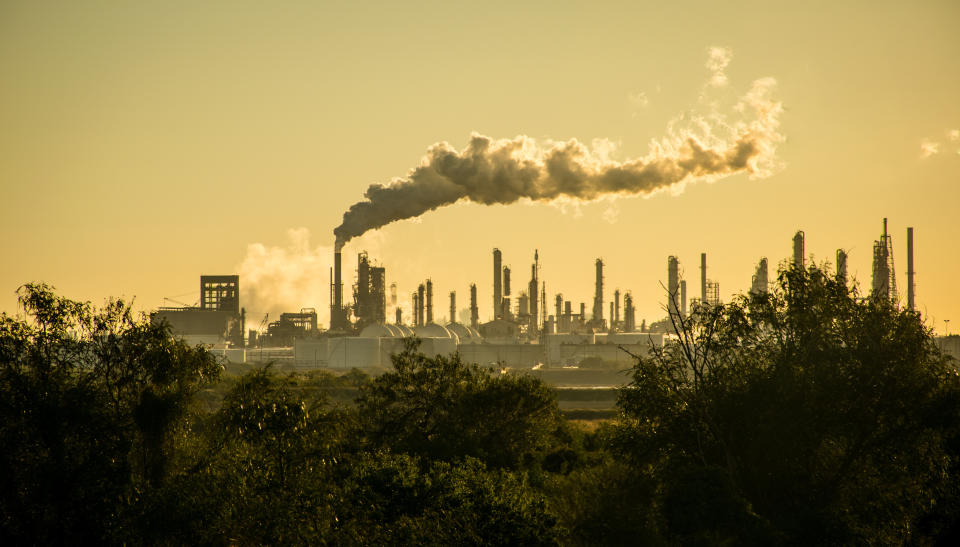On Carbon Emissions, Trump’s EPA Chief Wants To Have It Both Ways
If annual U.S. carbon emissions fall, it is thanks to President Donald Trump’s deregulatory agenda. If they rise, take it as confirmation that Trump has triggered an economic boom.
That’s how Andrew Wheeler, the acting chief of the Environmental Protection Agency and former coal lobbyist, has explained the decline and subsequent spike in greenhouse gas emissions during Trump’s first two years in office.
Wheeler’s agency credits Trump’s leadership for a 2.7 percent reduction in CO2 emissions from 2016 and 2017, writing in an October release that the president’s “regulatory reform agenda is spurring continued innovation in the energy sector.”
“The Trump Administration has proven that federal regulations are not necessary to drive CO2 reductions,” Wheeler said in an accompanying statement.
Since then, two separate analyses have documented a sharp rise in U.S. greenhouse gas emissions in 2018. Still, EPA touted the 2017 drop in greenhouse gas emissions in its 2018 year-in-review achievements. The list, published on Monday, makes no mention of last year’s increase in CO2 emissions.
The federal Energy Information Administration on Monday confirmed that carbon dioxide emissions from the U.S. energy sector jumped 2.8 percent last year ― the largest annual spike since 2010 ― primarily due to economic growth and weather conditions that drove up energy consumption. The report also forecasts that emissions from the energy sector will drop in each of the next two years ― by 1.2 percent in 2019 and by 0.8 percent in 2020 ― as a result of milder summer and winter weather, but that they will still remain above 2017 levels.
That federal analysis comes just three weeks after the Rhodium Group, an economic research company, released a report that estimates overall U.S. greenhouse gas emissions increased 3.4 percent in 2018, the second-largest annual increase in more than two decades. Along with a 1.9 percent spike in power sector emissions, increases occurred in the transportation, industry and buildings sectors. While a growing U.S. economy and a cold start to the year contributed to the overall rise, so too did the “limited progress made in developing decarbonization strategies,” according to the analysis.
The increase in emissions from the electric power sector would not have been as large without the administration’s regulatory rollbacks, Trevor Houser, an energy and climate analyst at Rhodium Group, told The Washington Post at the time.
“The tailwinds of Obama administration policy are dissipating,” Houser told HuffPost via email Tuesday. “Preliminary emissions trends from 2018 make it abundantly clear that energy market trends alone – the low cost of natural gas, the increasing competitiveness of renewables – are not enough to deliver sustained declines in US emissions.”

At a Senate confirmation hearing on Jan. 16, Wheeler downplayed both the threat of climate change and the Rhodium Group report. He acknowledged the emissions increase but attributed it to an “exceptionally hot summer and cold winter” and “more importantly, an uptick in manufacturing and industrial output.”
“We don’t expect that to continue,” Wheeler said. “We think the downward trend is going to continue in the long term.”
Wheeler’s comments came in response to questions from Sen. James Inhofe (R-Okla.), a vocal climate change denier. Inhofe said there had been “a lot of media spin” regarding Rhodium Group’s findings and that “a lot of the adversaries are wanting to blame” the spike on Trump’s environmental policy actions, including rolling back the Clean Power Plan, an Obama-era policy limiting greenhouse gas emissions from power plants.
“Economic growth has been phenomenal,” Inhofe said.
Wheeler went on to claim that the Affordable Clean Energy rule EPA proposed in August to replace the Clean Power Plan would reduce carbon dioxide levels by 34 percent below 2005 level. But as HuffPost has reported, EPA’s own analysis shows that the so-called ACE rule would lead to emissions increases that could result in up to 1,400 premature deaths each year by 2030.

The 2018 greenhouse gas spike comes after years of forward progress. Carbon dioxide emissions in the U.S. fell by about 14 percent between 2005 and 2017. At nearly every turn, the Trump administration has pointed to these declines to justify its fossil fuel-focused “energy dominance” agenda and pro-industry regulatory rollbacks. And Wheeler has used them to defend the president’s decision to withdraw the U.S. from the historic Paris climate agreement.
Last week, Utility Dive reported on a separate annual analysis by the Energy Information Administration showing that total U.S. emissions are forecast to drop by just 2.5 percent below 2017 levels by 2050, meaning the nation will fail miserably to meet the goals of the Paris accord, which aims to cut emissions 80 percent below 2005 levels by 2050.
“It’s increasingly difficult, though not impossible, for the U.S. to meet its international climate goals without ambitious federal action,” Houser said Tuesday.
A pair of sobering reports last year by the United Nations and scientists from more than a dozen federal agencies in the U.S. warned that sweeping cuts to global greenhouse gas emissions are required to stave off catastrophic climate change. Still, Trump and his team continue to dismiss the threat.
“I would not call it the greatest crisis,” Wheeler said at this month’s confirmation hearing.
Love HuffPost? Become a founding member of HuffPost Plus today.
Related Coverage
EPA Signals Andrew Wheeler Could Stay In Place Until 2020 Without Senate Confirmation
U.S. Emissions Spike Undercuts Trump Administration Push For Fossil Fuel Use
EPA Nominee Andrew Wheeler Downplays Climate Threat At Testy Confirmation Hearing
This article originally appeared on HuffPost.

